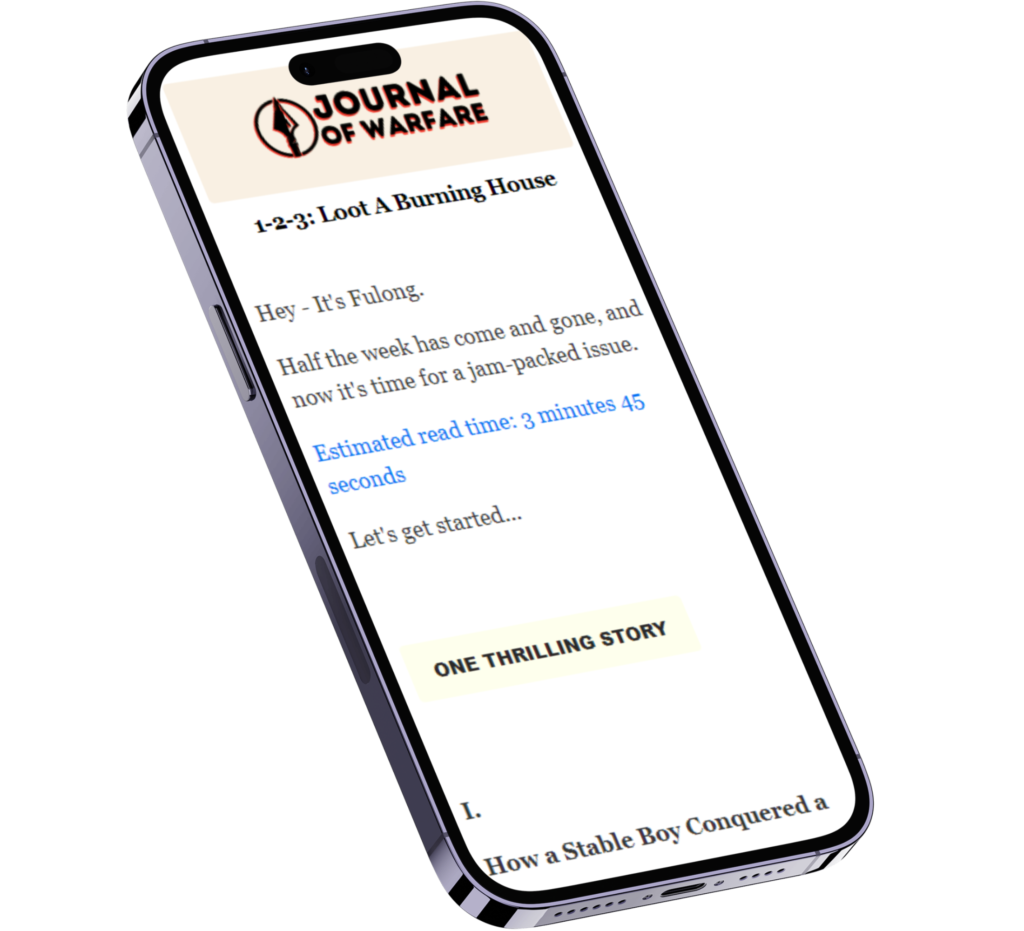Hey – It’s Fulong.
It’s the start of a bright new week, and now it’s time for a jam-packed issue.
Estimated read time: 2 minutes 5 seconds
Let’s get started…
One Thrilling Story
I.
The Battle That Made Nobunaga’s Name
In 1560 one of Japan’s greatest warlords, Oda Nobunaga, then still a minor commander, marched his force of two thousand men to stop the incursion of a rival warlord, Imagawa Yoshimoto.
Even though Nobunaga was outnumbered twelve to one he set out humming a tune.
Nobunaga’s scouts reported that Imagawa was resting his troops at a village that was nestled near a narrow gorge that Nobunaga knew would be ideal for a surprise attack.
The scouts further reported that Imagawa’s troops were celebrating and viewing the heads taken in a previous battle.
Nobunaga devised the following ploy.
He made camp some distance away from the village.
He placed numerous flags and had straw dummies made to give the impression that a large host had arrived.
Imagawa’s forces thus expected an attack to come from the direction of the enemy camp.
Meanwhile Nobunaga’s troops secretly made a forced march in a wide circle in order to come up from behind the Imagawa encampment.
The weather favored Nobunaga’s scheme, for late in the day there was a heavy downpour.
Taking advantage of the foul weather, Nobunaga’s troops launched a sudden attack from the rear.
So unexpected was this attack that Imagawa first thought that a brawl had broken out among his own troops.
Only when he saw two enemy samurai charging toward him did he realize he was under attack.
This realization came too late, and Imagawa was beheaded and his troops scattered.
The battle lasted only a few minutes, but it made Oda Nobunaga’s reputation and he quickly rose to power, eventually becoming one of Japan’s greatest warlords.
Two Warfare Lessons
I.
Split Your Attack Into Two
Attack the enemy with two convergent forces.
The first is the direct attack, one that is obvious and for which the enemy prepares his defense.
The second is the indirect attack, the attack sinister, that the enemy does not expect and which causes him to divide his forces at the last minute, leading to confusion and disaster.
II.
Sometimes A Feint Is Not Enough
Against a seasoned and wary opponent, feints will prove ineffective.
After all, the object of feint is to provoke a favorable reaction, therefore, if the enemy does not budge then it can be considered a failure.
Instead one must couple the feint with an actual attack to gain his attention.
Once his forces are concentrated on defending against the feint, you attack from a second direction, thus catching him by surprise.
Three Favourite Quotes
I.
Sun Tzu on indirect methods of warfare:
“To win victory in battle, the leader must know how to use both direct and indirect methods. The interplay between direct and indirect methods generates countless tactics.”
II.
Miyamoto Musashi on attaining victory:
“In battle, if you make your opponent flinch, you have already won.”
III.
Malcolm Gladwell on being the underdog:
“The fact of being an underdog changes people in ways that we often fail to appreciate. It opens doors and creates opportunities and enlightens and permits things that might otherwise have seemed unthinkable.”
See you next Monday — Fulong


